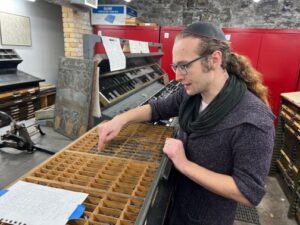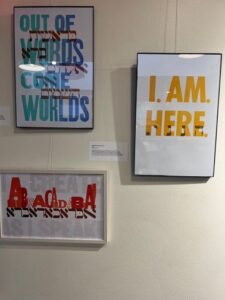Last summer local artists Noam Sienna and Robyn Awend went to upstate New York for the Hebrew Type Intensive, and said the energy was off the charts.
“We literally all landed at the place and started talking and did not stop,” said Sienna. “The energy was…there was like a hunger that all of us felt we were doing this on our own, and all of a sudden, we realized that there were other people who were doing it.”
That event helped inspire the April 10 and 11 Hebrew Type Symposium at the University of Minnesota and the Minnesota Center for Book Arts (1011 Washington Ave. S., Minneapolis). The two-day event brings together arts, experts and academics from the United States, Canada, and Israel, to discuss the business and art of Hebrew and Yiddish printing.
Sienna, also a historian, is a fellow in the Rare Book School’s Society for Critical Bibliography, part of which requires him to put on a symposium of his choosing, and the fellowship program puts in some funding for it. The program is also supported by Rimon: The Minnesota Jewish Arts Council, and the University of Minnesota Center for Jewish Studies. The first day’s sessions are at the Elmer Anderson Library at the U of M, and the second day will take place throughout the MCBA.

Noam Sienna, one of the curators of the Hebrew Type Symposium, shows some of the college of Hebrew typeface at the Minnesota Center for Book Arts. (Photo by Lonny Goldsmith/TC Jewfolk)
“Everybody was like, ‘How can we help you support this?’” Sienna said, who said that there had been a lot of surprise about the idea of a conference on Hebrew printing being in Minneapolis. “First of all, there’s a lot of people here. Second of all, there’s the Minnesota Center for Book Arts, which is one of the leaders in community-oriented print. And like the University of Minnesota Center for Jewish Studies, libraries, we have the Upper Midwest Jewish Archives. There’s actually a lot of resources here that are coming together. And I think people are going to people who are coming from outside, I think, are going to be blown away.”
A lot of the three floors of the MCBA is going to be used for Thursday, the second day of the program. But the magic happens in the basement wiith the Type Library and Letterpress Studio. Each participant in the Hebrew Type Symposium will get to make two different prints to take with them, utilizing two of the 19 different presses that the MCBA has.
“These aren’t just prints that people might file away,” Awend said. “These are actually ones we’ve been working hard to imagine how to impress even our most established printers that might be taking this workshop.”
Sienna said there is some metal, Yiddish type that is part of the MCBA Library that is about 100 years old, but no one is totally certain how it got there.
“The problem is that nobody has really kept good records,” Sienna said. “This is a nonprofit, it’s been here for 40 or 50 years. And every year, retired printers donate half a dozen cases of this or that. And it just kind of accumulates.”
Also, Sienna said, it’s really easy to conflate “font” with “typeface.” He explained that Times New Roman is a typeface, but a physical drawer of Times New Roman, bold, 12 point is a font.
Some of the Hebrew/Yiddish typeface he shows is in three different fonts of the same typeface: 12 point, 24 point, and 36 point. It doesn’t have a name but he said he thinks it dates back to the early 20th century. The letters are made from lead, and can be laid out individually to spell whatever word you’re looking to create.
Part of the Hebrew typeface collection is a relatively new set of wood-type letters, which made the MCBA the first public center in the country to offer multilingual alphabets for printing.
“It’s just a really incredible opportunity to be able to build the history with the type,” Awend said. “Oftentimes when you acquire type, it’s hard to know where it’s coming from or what it was. used for – and that’s also special because you’re carrying on and building a new industry with that type. But with brand new type, you get to be the first to build that history. And so it’s been deeply meaningful.”
The wood type was funded by a Minnesota State Arts Board grant in 2019, the wood type was manufactured at Hamilton Wood Type and Printing Museum in Two Rivers, Wis., which Sienna said is one of the last companies making wood type. Finding new lead Hebrew letters isn’t easy, either. It requires a foundry and mats with the Hebrew letters on them. The mats are slid in to metal rectangles which are filled with molten lead. When it cools, it has the letter on it to be used for printing.
“The big question for Hebrew casting is not so much who’s casting Hebrew type; anybody can cast Hebrew type, if they have the mats. The question is: where are the Hebrew mats for casting? And that there are not a lot of those.”
Sienna reached out to Sky Shipley of Arizona’s Skyline Type Foundry to see if he had the mats to make a new set of Hebrew type. He didn’t at the time, but reached out to Sienna a few months later to let him know he acquired some mats for Yiddish.
“This guy doesn’t know Hebrew says ‘I’m gonna send you a picture; Can you look at them and see if all the letters are there?’” Sienna recounted. “They’re all there. Unfortunately, not many sets of Hebrew mats survive – or as many as we would like.”
But one thing the symposium may be able to do is help create a centralized pool of knowledge.
“A lot of people who are interested in Hebrew printing, type, and typecasting have been working really independently,” Sienna said. “We really can all benefit, and so far that’s been the response. Nobody’s hoarding because there’s so little.”

Robyn Awend’s work at “(L)inking Letters: An Exhibition of Hebrew Letterpress Printing”(L)etters that Link Us” exhibit at the Minnesota Center for Book Arts. (Photo by Lonny Goldsmith/TC Jewfolk)
The new set of letters from Skyline will be part of a display on the third floor of the MCBA, where there is an art exhibit that’s open to the public through mid-May. “(L)inking Letters: An Exhibition of Hebrew Letterpress Printing” features 15 artists from around the world, from leaders in the space like Lynne Avadenka from Detroit to newer, up-and-coming artists like Sophie Edelhart from Toronto and Jacob Romm of New Haven, Conn.
Awend, who has several pieces on display, said letterpress as an art form allows her to connect her Judaism to her artistic practice – with a nod to her family lineage.
“My great-grandfather was a bookmaker and printer, so there’s a piece of my history that feels really honored when I do work in the studio,” she said. “We use words to communicate, but there’s so much more there. And especially in the Hebrew alphabet, where they say that there’s a whole universe inside each letter. [There’s] this endless knowledge that you could explore just in one letter.”
Different pieces in the exhibit showcase Hebrew and English in different ways in different prints, which Sienna said is the purpose of one of the panels on multilingual typesetting. Sometimes the Hebrew is on the right, with the English on the left. Others are switched. One has Hebrew at the top and English upside down coming from the bottom. Awend’s work in the exhibit overlays the Hebrew onto the English.
“There’s this whole concept of ‘text as image’ and how we use letters, letter fragments, words, word fragments, as graphic imagery that tells story, shares an idea, and evokes an emotion,” she said. “You can say a lot with a little. And so, to me, the beauty in that is finding ways to use text to create powerful work that can be very, not only thought-provoking, but relatable to others.”

